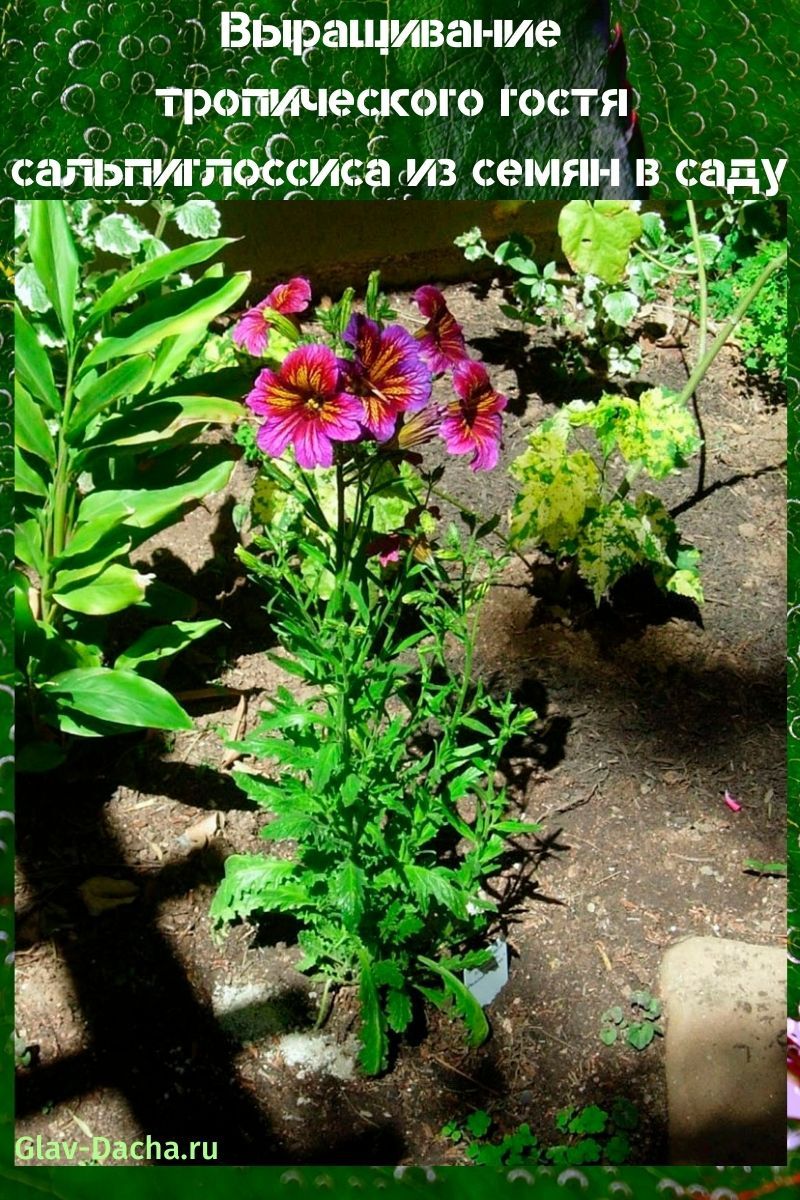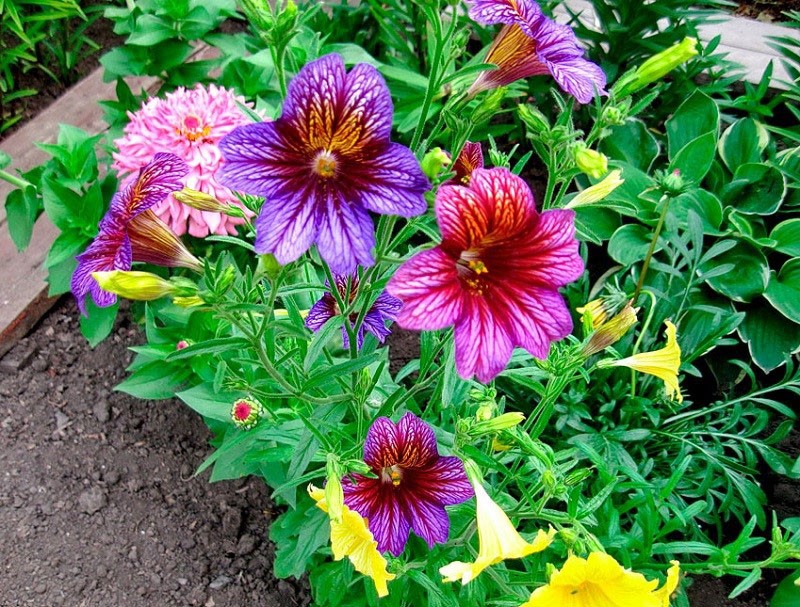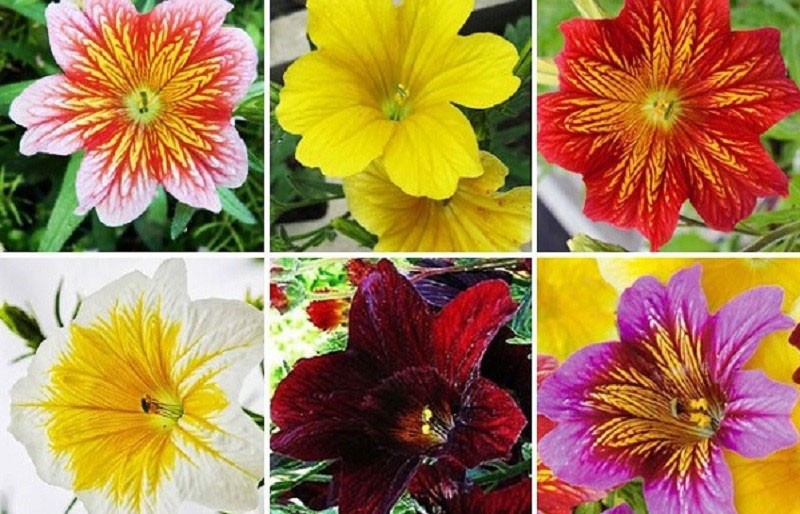Growing Tropical Guest Salpiglossis from Seeds in the Garden
 The attention of gardeners is attracted by the amazingly beautiful flower of the solanaceous family salpiglossis. The simple cultivation of salpiglossis from seeds is available even to novice hobbyists. The plant has a strong external relationship with petunia and bells. It is cultivated as a perennial, biennial and annual, depending on the region. The Latin name is Salpiglossis, translated as "language" and "pipe". Hence the second name for salpiglossis - the pipe-tongue.
The attention of gardeners is attracted by the amazingly beautiful flower of the solanaceous family salpiglossis. The simple cultivation of salpiglossis from seeds is available even to novice hobbyists. The plant has a strong external relationship with petunia and bells. It is cultivated as a perennial, biennial and annual, depending on the region. The Latin name is Salpiglossis, translated as "language" and "pipe". Hence the second name for salpiglossis - the pipe-tongue.
Description of the plant


External description of salpiglossis:
- Plant height about 1 m. Shoots are thin, straight and branched, covered with sticky hairs.
- There are 3 tiers of leaves on the stem. One tier is below, the second is in the middle of the stem, the third is near the top of the flower. The upper leaves are narrow and sessile, the middle ones are short-petiolate, the lower ones are alternate petiolar.
- Inflorescences of amazing color. Petals can be of any shade - from pale white to bright red or lilac and even brown. The buds are large, about 5 cm in diameter, resembling a gramophone in shape. There are varieties with corrugated petals.
Salpiglossis blooms for a long time, starting from early June until the onset of autumn frosts.
To understand the uniqueness of a flower, you need to see a photo of salpiglossis in a flower bed:

The subtleties of growing seedlings
 Growing salpiglossis seedlings from seeds makes it possible to accelerate its flowering.
Growing salpiglossis seedlings from seeds makes it possible to accelerate its flowering.
Sequence of actions for a florist:
- selection of high-quality seed;
- preparation of containers and soil for seedlings;
- sowing with exact timing;
- plant care;
- landing at a permanent place.
Each paragraph has nuances, you need to know and use them.
Seed preparation
 The seeds are distinguished by high germination capacity, retain the ability to germinate for 4-5 years. The main condition is to store them in a dry and cool place without exposure to light.
The seeds are distinguished by high germination capacity, retain the ability to germinate for 4-5 years. The main condition is to store them in a dry and cool place without exposure to light.
When buying seeds in a store, you need to pay attention to the date of collection, not packaging.
To get his own seed, the gardener must harvest the seeds correctly. First, choose the variety you would like to multiply. Then, on this plant, remove almost all wilted buds, leaving the largest ones for subsequent collection of seeds.
Timing
 The second question when growing salpiglossis from seed is when to plant?
The second question when growing salpiglossis from seed is when to plant?
In the open field, you can grow seedlings only in the southern regions. Salpiglossis needs a mild and warm climate for good growth. Sowing is allowed in late autumn (late October) or spring (late April - early May). In areas of the middle lane, only sub-winter sowing is recommended. In the spring, the grown plants should be transferred to a permanent place.
When growing indoors, the timing is recommended to be calculated more accurately. Seedlings are ready for planting in 40-50 days after sowing.
Usually, salpiglossis is placed in flower beds in mid-May, which means that sowing should be started in late March or early April. In the southern regions, the sowing date is shifted to early March.
Soil and container
 When growing salpiglossis from seeds, you need to prepare high-quality soil. The soil should be nutritious but light.
When growing salpiglossis from seeds, you need to prepare high-quality soil. The soil should be nutritious but light.
The salpiglossis plant does not like acidic soil.
To prepare the soil mixture, you will need to take sod land, wood ash and fine sand in a ratio of 2: 1: 2. Mix the components well and add peat. The proportions of peat and soil mixture - 1: 2. There is another worthy option - to buy a ready-made mixture for flower seedlings. It contains all the essential nutrients.
 The choice of containers for sowing should be taken very carefully. Salpiglossis has an increased sensitivity to transplants and moisture retention. To reduce root damage when picking and replanting seedlings, it is better to use separate pots or cups. And in order to avoid stagnation of water, make a drainage layer and holes in the glass for the outflow of moisture.
The choice of containers for sowing should be taken very carefully. Salpiglossis has an increased sensitivity to transplants and moisture retention. To reduce root damage when picking and replanting seedlings, it is better to use separate pots or cups. And in order to avoid stagnation of water, make a drainage layer and holes in the glass for the outflow of moisture.
Growing salpiglossis from seed to seedlings

Algorithm for planting seeds for seedlings:
- Lay a drainage layer at the bottom of the container - small pebbles, pieces of foam plastic, expanded clay.
- Fill the container with soil mixture and moisten it with clean water from a spray bottle.
- Place 3-5 seeds in each glass. Press lightly against the surface without burying. If one planting container is prepared, then the seeds must be distributed with a toothpick.
- Re-moisten crops.
- Place the cups on one common tray or tray. Cover with foil or glass.
- Transfer to a windowsill where there is no direct sunlight. If such a place cannot be found, then future seedlings should be shaded with a sheet of white paper.
The air temperature should be maintained in the range of + 20 ° С… + 22 ° С.
Salpiglossis seeds do not need stratification or pre-planting. They initially have a high resistance to pathogens.
Crop care
 When growing salpiglossis from seeds, there are two important steps - planting and proper care of the seedlings. The first shoots appear 15-20 days after sowing. Until this time, it is necessary to regularly ventilate mini nameplate and remove condensation. As soon as the seeds hatch, you should not immediately remove the film. It is necessary to open crops every day, gradually increasing the ventilation time. First, you can open the seedlings for 1-2 hours, then increase the time to 3-4 hours, and after 4-5 days, remove them completely.
When growing salpiglossis from seeds, there are two important steps - planting and proper care of the seedlings. The first shoots appear 15-20 days after sowing. Until this time, it is necessary to regularly ventilate mini nameplate and remove condensation. As soon as the seeds hatch, you should not immediately remove the film. It is necessary to open crops every day, gradually increasing the ventilation time. First, you can open the seedlings for 1-2 hours, then increase the time to 3-4 hours, and after 4-5 days, remove them completely.
Temperature control and lighting
 In the first stage of growth, seedlings need moderate lighting. It is important to keep away from direct sunlight. After 2 weeks, when the salpiglossis seedlings get stronger, it is necessary to organize additional lighting. Daylight hours for plants must be extended to 12-14 hours. The optimum temperature for seedlings is no more than + 18 ° С… + 20 ° С.
In the first stage of growth, seedlings need moderate lighting. It is important to keep away from direct sunlight. After 2 weeks, when the salpiglossis seedlings get stronger, it is necessary to organize additional lighting. Daylight hours for plants must be extended to 12-14 hours. The optimum temperature for seedlings is no more than + 18 ° С… + 20 ° С.
Watering and nutrition
Watering should be dosed. For irrigation, it is recommended to take settled water at room temperature and a spray bottle.
It is important to ensure that the soil does not dry out, but you do not need to water the plants either. Seedlings do not need fertilizing. The main food should be added after transplanting into the ground.
Pick and pinch
 To reduce root damage, seedlings should be picked early. The best time is when the first 2 true leaves will form on the plants. You need to transfer seedlings with a clod of earth and very carefully. After picking, install props for them. The delicate stems can break as the leaves grow.
To reduce root damage, seedlings should be picked early. The best time is when the first 2 true leaves will form on the plants. You need to transfer seedlings with a clod of earth and very carefully. After picking, install props for them. The delicate stems can break as the leaves grow.
When the height of the seedlings reaches 10 cm, break the tops of the heads. Pinching salpiglossis will have to be repeated 2-3 more times before transplanting to a permanent place. When the flower grows in the flowerbed, continue to regularly pinch the tops, simultaneously removing the faded heads.
Hardening
 Salpiglossis is cultivated in the open air. Therefore, 3 weeks before the planned transplantation date, you should start hardening the seedlings. For the first days, a 15-minute walk in the fresh air is enough for the plants, then the time should be gradually increased.
Salpiglossis is cultivated in the open air. Therefore, 3 weeks before the planned transplantation date, you should start hardening the seedlings. For the first days, a 15-minute walk in the fresh air is enough for the plants, then the time should be gradually increased.
Transfer
 As soon as the threat of return frosts has passed, you can start decorating the flower bed.
As soon as the threat of return frosts has passed, you can start decorating the flower bed.
The main nuances of planting and caring for the salpiglossis flower:
- The distance between the two plants is at least 30 cm. The bushes grow well and will quickly fill the voids.
- It is recommended to dig up the site in advance, prepare holes before planting.
- It is important to ensure that the earthen lump does not crumble when transplanting salpiglossis.
- After planting, the bushes need to be watered, and the ground must be mulched.
- After 5-7 days, feed the salpiglossis with a complex mineral fertilizer for flowers. Then, after a week, add wood ash.
It is necessary to take into account the fragility of the flower so as not to damage the stems when watering.
 If you want to add beauty to the site, then it is difficult to choose a plant better than salpiglossis. It doesn't matter that it is an annual. When grown from seed, it will bloom early, and until the very frosts will delight with lush inflorescences.
If you want to add beauty to the site, then it is difficult to choose a plant better than salpiglossis. It doesn't matter that it is an annual. When grown from seed, it will bloom early, and until the very frosts will delight with lush inflorescences.